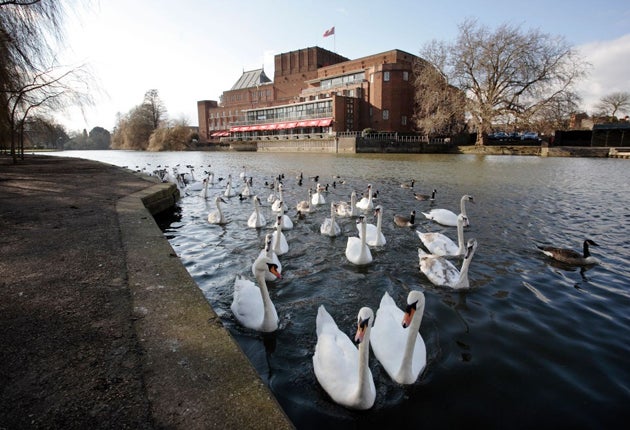A guide to A-road Britain: A3400
If you are heading northwards into Shakespeare country, choose the route the Bard himself would have travelled. Emily Dugan saunters to Stratford-upon-Avon from Chipping Norton through chocolate box Olde England

Your support helps us to tell the story
From reproductive rights to climate change to Big Tech, The Independent is on the ground when the story is developing. Whether it's investigating the financials of Elon Musk's pro-Trump PAC or producing our latest documentary, 'The A Word', which shines a light on the American women fighting for reproductive rights, we know how important it is to parse out the facts from the messaging.
At such a critical moment in US history, we need reporters on the ground. Your donation allows us to keep sending journalists to speak to both sides of the story.
The Independent is trusted by Americans across the entire political spectrum. And unlike many other quality news outlets, we choose not to lock Americans out of our reporting and analysis with paywalls. We believe quality journalism should be available to everyone, paid for by those who can afford it.
Your support makes all the difference.When Shakespeare made his way from London to the family home in Stratford-upon-Avon, it is safe to assume he did not shove his quills in the boot of a Vauxhall Astra and tear along three lanes of tarmac. No.
The M40 is hardly a journey fit for the Bard and – anachronisms aside – the road he would have taken after Oxford is the current A3400.
On the map it looks fairly unremarkable: the names of the villages it passes through are not well known; the countryside is not national parkland, and there are few sites you would find in a guidebook to Britain. Yet the journey through the Cotswolds is unrivalled for capturing the kind of rural England not often seen outside E H Shepard illustrations. If there was one road on which to dump a Japanese tourist in search of that long-lost lid-of-the-biscuit-tin scene, this is it.
The road begins as a branch from the A44 just outside the market town of Chipping Norton. Though the A3400 continues northwards beyond Stratford, we will focus on the first stretch, which would have made up the final hours of the Bard's commute from London. If you want to make the journey from London, turn off the M40 at junction 10 and follow signs to Chipping Norton – a market town that is well worth stopping in, despite it being home to Jeremy Clarkson.
Within a few minutes of beginning the road, a stone sign reads "Cotswolds: area of outstanding natural beauty". Then as if on cue, the countryside unfurls itself in front of the road, a cliché of English charm. Even the forecourt shop at the Shell garage is built in the warm yellow of Cotswold limestone.
It is easy to miss the road's first notable landmark, but it is worth studying the map to make sure you don't. The Rollright Stones – otherwise known as the Stonehenge of Oxfordshire – are not signed from the road, but lie just next to it. After three miles of the A3400, you will find a small turn-off to the village of Little Rollright – the stones are just a few hundred yards down this turning, hidden behind a rather unpromising-looking layby. Far from the fenced off slabs at Stonehenge, this Neolithic site is completely unguarded, allowing you to see it almost in its original setting. The most impressive of the ancient monuments is The King's Men, a ceremonial stone circle dating from 2500BC.
Back on the road, it is now time to cross a county border, an event which is worth noting, if only because – unlike Oxfordshire – Warwickshire has not taken pity on its motorists and turned off its speed cameras. Soon after, you reach Long Compton, a village which, as its name suggests, is the longest in the Cotswolds. If you have been driving from London, this is an ideal spot to stop and eat, firstly because it has a fine gastro pub and a farm shop selling delicious home-made rolls, but also because it's a picturesque place to stretch your legs.
The road continues through the village until you reach Long Compton's church, St Peter and St Paul on the left. The 13th-century building boasts a unique lychgate which has a small room above it, giving it the look of a tree-less treehouse.
The next big place is Shipston on Stour. This market town, built around a pretty cobbled square, has seen better days. It is worth a stop, however, if you have a fondness for the kind of shops rendered redundant elsewhere. Expect to find bric-a-brac shops with genuine antiques next to rather threadbare Paddington Bears and broken teapots; hardware stores that still sell nails by the nail, and window displays that have the owner's dog wandering through them.
After Shipston, the road reverts to small villages and fields. Hedgerows and small farms pass by on either side, punctuated by "tractors turning" signs, stone walls so neatly tessellated they have made concrete superfluous and shut-looking farm shops. The prettiest of these villages is Newbold on Stour, which still has its traditional pub, village green and bowls club and is the kind of village that – from the outside at least – seems to have been unblemished by the designer welly brigade.
A couple more miles later you reach the River Avon. Crossing over it on a bridge flanked by armies of swans and barges, the Royal Shakespeare Company's theatre comes into view – now you are officially in Shakespeare country.
Join our commenting forum
Join thought-provoking conversations, follow other Independent readers and see their replies
Comments